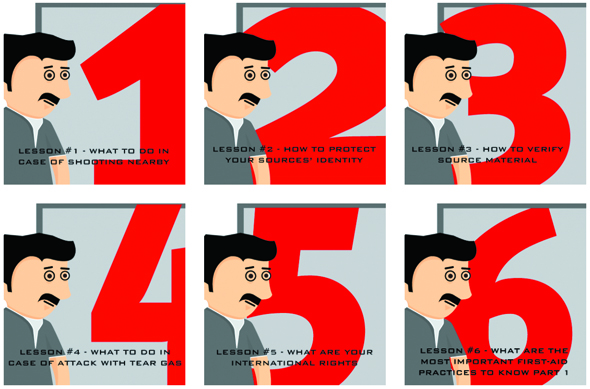
The Journalist Survival Guide does not use the phrase “survival guide” lightly. That much is clear by Lesson 1: “What to do in case of shooting nearby.” (Get behind a hard, thick barrier and don’t try to get a view of what’s going on; wait 10 to 20 minutes after gunfire stops before coming out; and remember that protection from view does not mean protection from fire.)
Released in August by the Lebanon-based SKeyes Center for Media and Cultural Freedom, the unconventional how-to manual seeks to fill a void in do-it-yourself correspondent preparation. “Young freelance journalists are going to the most dangerous places in the world without any kind of training,” says Ayman Mhanna, the executive director of the SKeyes Center. The organization is a subsidiary of the Samir Kassir Foundation, which works to defend freedom of expression in the Arab world in memory of a journalist assassinated in Beirut in 2005.
The Journalist Survival Guide consists of 14 animated videos in Arabic and English. Each has a different focus, ranging from physical safety (Lesson 2: “How to protect your sources’ identity”) to online security (Lesson 12: “How to permanently delete sensitive information”). With funding from the National Endowment for Democracy, the SKeyes Center worked with the Lebanese Red Cross and other organizations to develop the content.
Their protagonist is a mustachioed cartoon journalist with a perpetually worried expression who dodges tear gas, secures his Skype account, and encrypts his internet communications while a voice-over narrates each lesson. The style is playful given the gravity of the topic, but Mhanna believes that approach is more accessible. “Humor is one of the best channels to communicate information,” he says. And animation has other benefits. It is cheaper to produce than video and needs less bandwidth to play, allowing animated videos to reach a wider audience in places with weak internet connections, like Syria.
The Journalist Survival Guide did begin with Syria in mind, but the final product is for anyone who needs it. “In all the videos, we don’t mention Syria,” says Maroun Sfeir, the executive producer of the video series.”We kept it vague on purpose because we believe that it’s beyond Syria.”

